“Peru is savage. One of the world’s most biodiverse countries, Peru came at Team Substantial from all angles. Kayaking in a place where the deepest and most remote canyons in the world cut through the second highest mountain range on earth is not easy. We traveled to Peru to do overnight expeditions and paddle great whitewater…what we got was the adventure of a life time. Enjoy the 35 min story of the trials and tribulations we faced on our month long Andean Adventure.”
Unique Tandem Self Rescue!
Anyone who has had to self-rescue a double kayak can attest it takes communication and coordination, with bow and stern paddlers re-entering the kayak one at a time. But what if both paddlers were to re-enter the kayak together… upside-down? Leave it to an Adventure Kayak reader to find out the answer.
“I’m an ACA coastal kayak instructor trainer in Brazil and was inspired by the video posted [on the website of Adventure Kayak’s sister publication, Canoeroots] about the Fontaine Flop rescue in a canoe,” writes Christain Fuchs, of Brazilian outfitter and instruction center, Aroeira Outdoor. “We lauched a challenge, to make it with a tandem sea kayak, and here is the result!” Watch the video to see how it’s done.
See more kayak techniques and adventures on Aroeira Outdoor’s YouTube channel.
Buy A Boat, Give A Boat In Support Of Team River Runner
“From May 15-June 15, for every boat purchased through a retailer or www.bellyak.com, a portion of the proceeds will be used to provide bellyaks for Team River Runner, a non-profit organization serving Veterans through adaptive sports.
Bellyak, makers of personal adventure boats (or lay on top kayaks), announced a new Buy a Boat, Give a Boat program today to benefit Team River Runner, a volunteer non-profit organization focused on the active, safe and positive support of healing service members and their families. From May 15, 2014 until June 15th for every boat purchased through a retailer or Bellyak’s website, a portion of the proceeds will be used to provide bellyaks for Team River Runner, a non-profit organization serving Veterans through adaptive sports.
“Seeing the positive changes the bellyak has provided people with disabilities has been a highlight of our business. Due to the lay on top, intuitive design of the Bellyak, people with disabilities have been able to enjoy watersports with minimal adaptation required, giving them mobility and exercise in an easy to use format,” said Adam Masters of Bellyak. “With our customers and retailers support, we will supply 14 chapters with two bellyaks each over the next month.”
Longer than a riverboard, more stout than a surfboard and shapelier than a standard SUP, a Bellyak is a boat designed to be ridden lying down, without restricting straps or a confining spray skirt. Bellyak’s innovative design lets people of many different skill levels and physical abilities enjoy the water.
“We have two Bellyaks that we use at Team River Runner Fort Belvoir/Quantico. Many of our participants have experienced Traumatic Brain Injuries (TBI) and have balance issues. This is a fantastic tool for us to get our participants on the road to healing and health,” said a Team River Runner representative.
In addition to providing a therapy outlet for recovering amputees, Team River Runner facilitates paddling therapy sessions for active-duty and veteran service members who are coping with Traumatic Brain Injury, Post Traumatic Stress Disorder, Spinal Cord Injury, or Emotional Impairment. Team River Runner’s motto is “Health and Healing Through Paddlesports.”
Bellyaks are designed to be used on any type of water. This is especially great for programs like Team River Runner because their paddling sessions always begin in a swimming pool and later progress to outdoor venues, such as a lake, coastal inlet or river.”
Read Rapid’s review of the Bellyak Play.
About Team River Runner
“Team River Runner believes that every wounded and disabled veteran deserves the opportunity to embrace new challenges. They believe the struggle of physical and emotional recovery needs to be supplemented with activities that spark competitiveness, invoke leadership, and promote camaraderie. Team River Runner provides an outlet to fulfill these beliefs – inviting wounded and disabled war veterans and their families to participate in adaptive paddling programs.
Team River Runner was founded in 2004 at Walter Reed Medical Center. They now offer weekly paddling sessions in 45 locations nationally and locally. Programs include biathlons in Washington, D.C. and Colorado, a Kayak Football Tournament at Walter Reed, and many other activities and events. They’ve placed an increasing emphasis on the development of leadership skills for our participants and host leadership clinics around the nation. Veterans learn the skills to become leaders of their TRR chapter.
Team River Runner is more than an adaptive sports program. It’s a program that provides hope and healing to those who have risked so much, yet asked for so little. It’s an opportunity to enjoy nature and realize its social, physical, and emotional benefits, whether it’s tackling whitewater rapids or paddling on peaceful flat-water. It’s an environment that facilitates connection, allowing veterans to reunite with their families and forge relationships with those who have endured similar pain. More than anything, Team River Runner is a program that provides purpose for those who need it most – the wounded and disabled war veterans of the United States of America. Our veterans are on the river to recovery.”
About Bellyak
“Bellyak was founded in 2011 by Adam and Anna Masters. Adam, a lifelong kayaker from a kayak manufacturing family invented and patented the bellyak concept. From his experience he knew that being trapped in a kayak was the biggest deterrent to paddlesports, and wanted to create a watercraft that was intuitive and accessible for all types of waterlovers. Bellyak offers innovative lay on top kayaks for river, surf or lake. Designed to be ridden lying down, kneeling or seated without restricting straps or a confining sprayskirt. With a size to fit everyone, Bellyak offers maximum fun with a minimum learning curve. 100% designed and made in the USA.”
7 Rivers 7 Continents: Russia
In early May 2014, expedition kayaker Mark Kalch began the next leg of his world first 7 Rivers, 7 Continents project to complete paddling descents of the longest river on each continent. This is a combined distance of more than 22,000 miles (35,500 km). He has already become the first person to ever paddle the entire Missouri-Mississippi and Amazon rivers in North and South America, respectively. Mark has now set his sights on the 2,300-mile (3,700-km) Volga River in Russia, Europe’s longest.
The project’s goal, beyond successful descents, is to record and compile audio-visual and written pieces capturing the influence the waterways have had on the growth of civilizations and impact on the surrounding ecosystems.
The place that the Volga itself holds in Russia’s culture, history and indeed existence cannot be overstated. From northwest of Moscow, it flows east, then south through giant, industrialized urban centers, past vast steppes in complete natural isolation and is punctuated by some of the largest reservoirs on the planet. It empties into the Caspian Sea by way of its huge delta.
The descent, which began May 6, will record life in communities both on the river and in those influenced by the river.
From the fisherman, the hunter, the family and the hydroelectric worker, to the farmer, the city dweller, the trees, the predator and the prey, all have inspiring and thoughtful stories to reveal. Sharing these stories provides an opportunity to inform, educate and inspire an international audience regarding the importance of the world’s greatest rivers.
Mark says, “Paddling these immense waterways from source to sea is a physical and mental challenge like no other. The great rivers of the world have shaped the very existence of humans and the ecosystems in which they live. As a result issues such water scarcity and food security are fast becoming one of the planet’s most pressing dilemmas. Beyond testing the limits of human performance, the project will provide a unique insight into the life rivers have built and sustain.”
The river’s on the 7 Rivers, 7 Continents hit list:
Amazon River (South America), 4150 miles – completed 2007/2008
Missouri – Mississippi River (North America), 3780 miles – completed 2012
Volga River (Europe), 2300 miles – commenced May 6, 2014
Nile River (Africa), 4132 miles
Yangtze River (Asia), 3916 miles
Murray-Darling River (Australia), 2904 miles
Onyx River (Antarctica), 25 miles
Kokatat MsFit PFD Review
Few pieces of your paddling kit are as critical as your personal flotation device (PFD). For industry-leading safety, comfort, style and convenience, the Kokatat MsFit Tour is a perfect fit for a wide variety of paddlers. There’s good reason this is the vest of choice for everyone from expedition paddlers like Justine Curgenven and Marc DeLuca to world-class coaches like Leon Sommé and Shawna Franklin.
Veteran of day trips and extended tours on ocean coasts, inland seas, lakes and rivers, our orange MsFit Tour is faded from so many days in the sun, but it’s never pulled a seam, busted a buckle or otherwise let us down, and it still floats like a champ. Kokatat’s excellent customer service and lifetime warranty offers peace of mind if it ever does need a fix.
The MsFit’s clever moniker and princess seams point to its original women’s specific tailoring, but this PFD is equally suited to barrel-chested blokes and anyone who appreciates a bit more breathing room. Articulated foam panels and a center zip make this an all-day comfortable and very easy on-and-off vest with classic styling available in red, mango, glacier blue or canvas. The padded high back protects your spine if you roll in a rock garden or get chundered in the surf.
Other features we appreciate include front and rear reflective tape for increased visibility on (or in) the water after dark, a tidy knife garage in an easy-to-reach location on the chest, and padded thermoformed shoulder straps for improved comfort.
Touring paddlers, anglers and gadget geeks will especially appreciate the MsFit’s two large, zippered pockets and a third clip-closure electronics pocket that’s sized just right for a VHF radio or other communications device. This vest is truly in a class of its own when it comes to useful yet compact storage. The MsFit’s twin bellowed pockets are slim yet expand to stash essentials like your compass, flares, fire-starter, first aid supplies, prussiks, snacks, sunscreen and more.
Truly the multi-tool of PFDs, Kokatat’s MsFit Tour remains one of our favorite grab-and-go vests for afternoon tours by kayak, canoe or SUP, and a trusted companion for all of our hairiest adventures.
$149 | www.kokatat.com
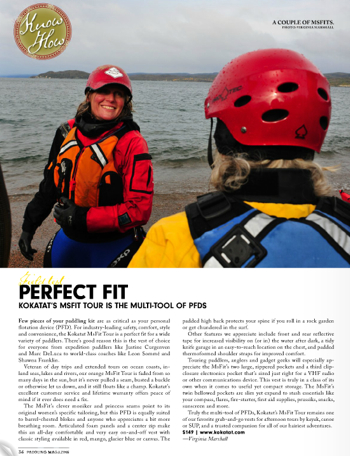
Skills: Tandem Basics
Learn from the basics of tandem paddling from lengendary canoeist, Bill Mason, in Path of the Paddle: Doubles Basic presented by the NFB below.
“This short film from canoeist Bill Mason demonstrates the basic doubles paddling strokes and how to apply them in various combinations. The application of each stroke in rapids is shown briefly and the emphasis is always on working as a well-coordinated team.”
Path of the Paddle: Doubles Basic by Bill Mason, National Film Board of Canada
Video: State Of Matter, Extreme Kayaking
“In May of 2012, a small international team took on a bold expedition to use the Homathko River to access B.C.’s Mt Waddington. Kayaking one of the continent’s most exciting multi-day river trips and skiing the Coast Range’s biggest peak in the same trip, it was a mission of epic proportions – especially because climbing/mountaineering and kayak paddling seasons do not usually overlap. Finding safe river and snow conditions for boating, climbing, and skiing would be the crux of the expedition. Did they succeed? Watch this kayaking video and find out. Producer: Jules Domine Athletes: Maxi Keinwasser State of Matter, Extreme Kayaking in Canada | Water & People, Ep. 1”
From Epic TV.
Bellyak Play Review
Our neoprene-mitted hands slap in the air and we slither onto our boats, stoked to be seeing our home river from a whole new angle. Paddling head-first on the Bellyak Play gives a fresh perspective to a familiar run.
With its boogie board-meets-playboat look, this lay-on-top design turns heads as it carves you headlong into the fun.
Bellyak Play 25/35/45
LENGTH 6’1”/7’7”/7’7”
WIDTH 20”/24”/25”
VOLUME 25/35/45 GAL
WEIGHT 22/25/30 LBS
PADDLER WEIGHT 60–110/ 70–150/150–250 LBS
MSRP $550 USD
www.bellyak.com
All the usual principles of whitewater apply: get some speed, hold your angle and if you don’t tilt into your turns, you’ll bite it.
At first glance, the Play might seem like a hard-to-control way to get downriver, but as I start goofing around in current, I find the boat’s stability and maneuverability confidence inspiring. Even better, I’m happy to discover that the full and rockered bow protects my head from oncoming rocks. Almost eye-level with the waterline, I feel less like a boater and more like a river creature.
Designer Adam Masters made his first Bellyak prototype by chopping a playboat in half and filling it with foam—he wanted to add challenge to class III and IV runs by paddling prone. The idea has caught on.
Masters says most people picking up Bellyaks are hoping to spice up their home runs or they’re newbies, wanting to try whitewater without the fear of being trapped in a kayak.
When I first flopped onto the water I wondered why the neoprene paddling mitts that come with the Bellyak don’t have stiff plastic for more water grip, but I soon learned why they’re floppy. Within nanoseconds of a swim, I could quickly scramble back on-board using the easy-to-grasp handles, conveniently located all around the boat.
The instantaneous exit makes it a great ride for beginners, building strong links between on-water mistakes and sudden swims.
Not being attached limits the boat from running big, pushy whitewater but Bellyaks are great for park and play surfing, and low-volume beginner to intermediate runs, says Masters.
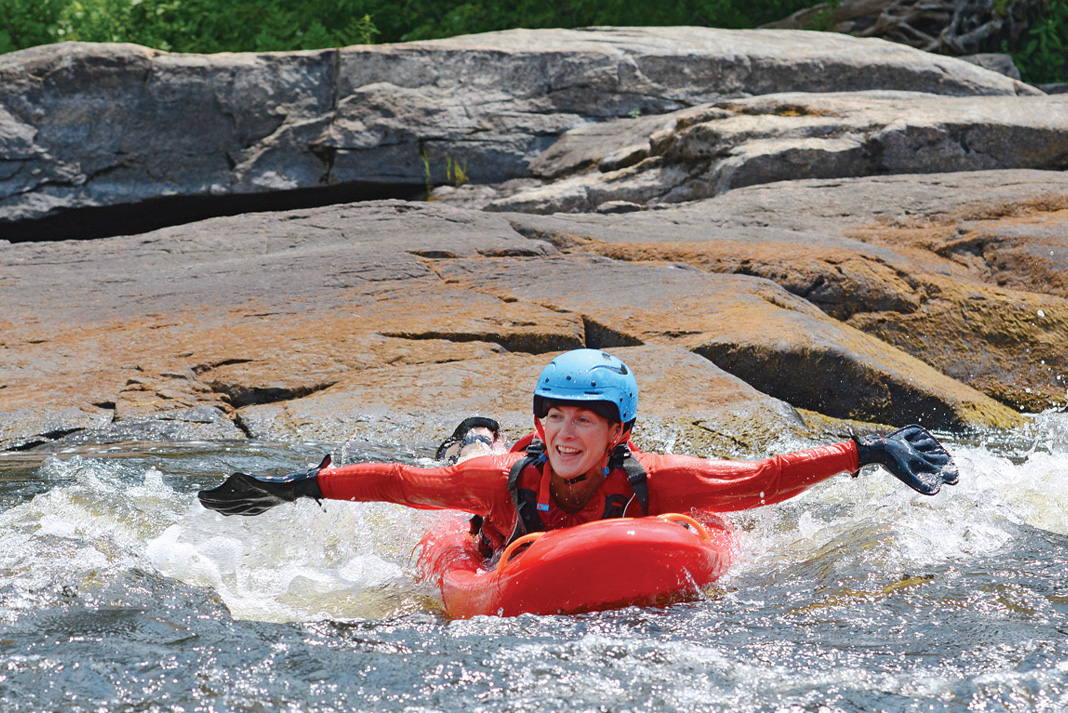
My home river is drop and pool and between sets I try sitting up to paddle to the next rapid. It’s nice to get up for a stretch, but stability and directional control are compromised when I’m kneeling—Bellyaks are definitely best used prone.
All that hand paddling is a workout, and the soft mitts, which help fine-tune the boat’s direction by allowing me to feather in current, don’t contribute much to flatwater speed.
At just 30 pounds, portaging the Play is a breeze; the boat is easy to hold under an arm or drag using a handle.
Just like a playful otter, I find myself running the same section of river over and over again, careening in and out of eddies, surfing head-first and jet-ferrying this way and that, using only my neoprene paws to get around.
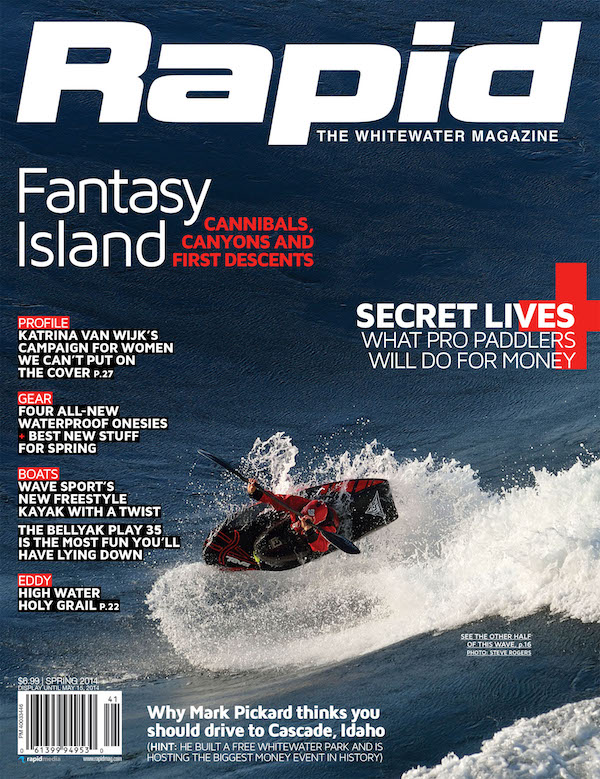 This article was first published in the Spring 2014 issue of Rapid Magazine. Subscribe to Paddling Magazine’s print and digital editions, or browse the archives.
This article was first published in the Spring 2014 issue of Rapid Magazine. Subscribe to Paddling Magazine’s print and digital editions, or browse the archives.



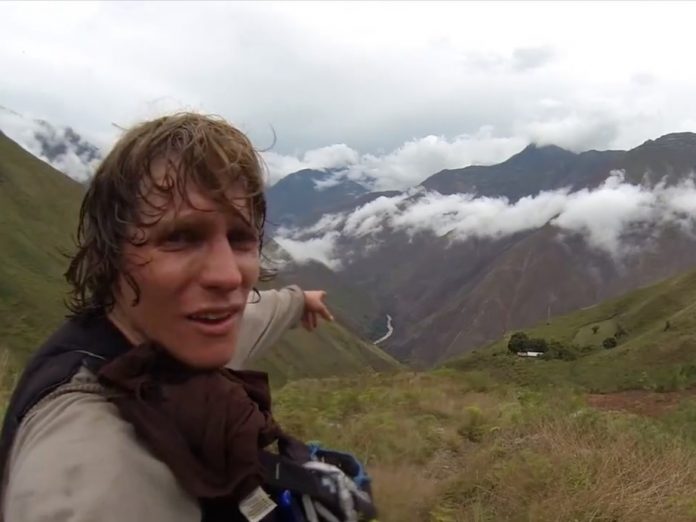

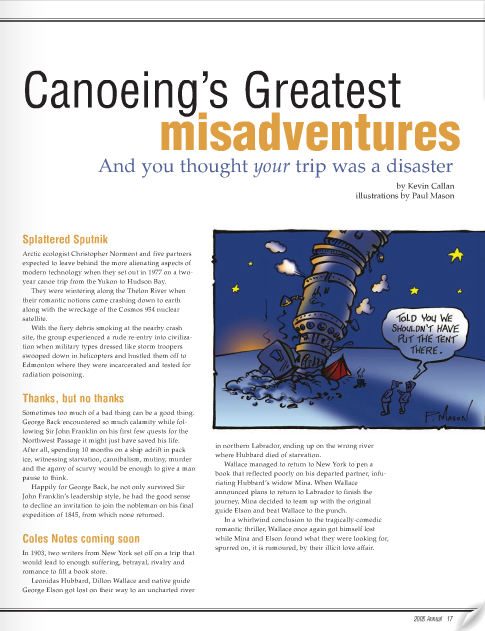 Get 7 more stories of misfortune and continue reading this article in the digital edition of Canoeroots and Family Camping, 2004, on our free
Get 7 more stories of misfortune and continue reading this article in the digital edition of Canoeroots and Family Camping, 2004, on our free 

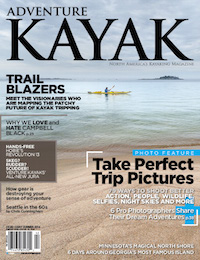 This article first appeared in the Early Summer 2014 issue of Adventure Kayak Magazine.
This article first appeared in the Early Summer 2014 issue of Adventure Kayak Magazine. 




